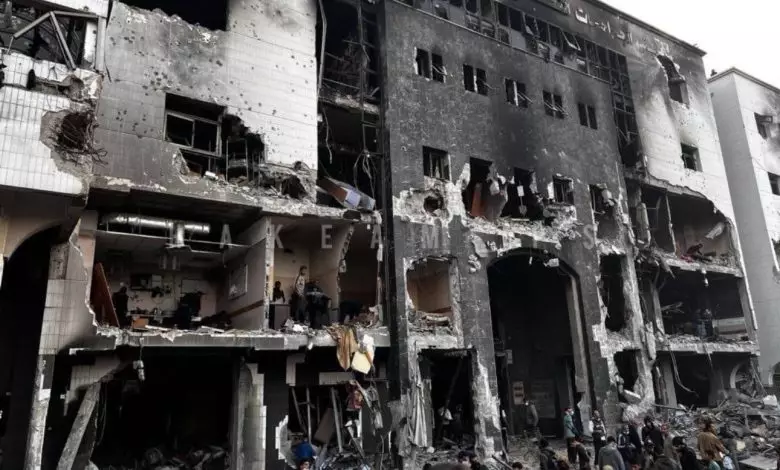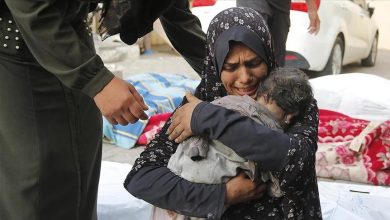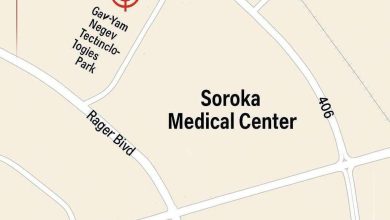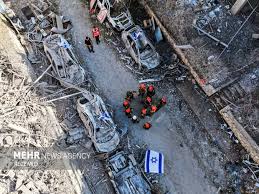Statistical Report: Gaza’s Hospitals and Schools Decimated Amid Ongoing Conflict
In the ongoing conflict that has escalated since October 7, 2023, Israeli forces have intensified their offensive on the Gaza Strip. This escalation has seen hospitals and schools increasingly targeted, a development that starkly contravenes international humanitarian law which designates such structures as safeguarded during wartime.

Since the onset of the comprehensive conflict initiated by Israeli forces on the Gaza Strip from October 7, 2023, critical infrastructure such as hospitals and schools have come under direct attack, contravening international humanitarian law that safeguards these structures during conflicts. Recent months have revealed a systematic approach by Israel, targeting essential components of civilian life, seemingly to weaken Palestinian society, undermine its resilience, and drive the population to a point of desperation.
A significant number of hospitals have been rendered fully or partially inoperative following bombings or shortages of fuel and medical supplies. Simultaneously, hundreds of schools have suffered bombings, been destroyed, or have become unsafe shelters due to severe overcrowding. The data indicates that this targeting is not haphazard but rather part of a deliberate strategy to render the Strip uninhabitable and unsustainable, potentially facilitating enforced displacement and depopulation initiatives.
The report meticulously outlines the numerical data and instances of violations that reveal the scale of damage inflicted upon the health and education sectors in Gaza. It argues that Israel has effectively targeted education and healthcare as part of a complex military campaign against the Palestinian population and its infrastructure. The report claims that this strategy relies on unsubstantiated allegations, lacking any concrete proof that the medical and educational systems have forfeited their civilian and humanitarian status, a position supported by various United Nations and international assessments.
According to the latest figures released by the Palestinian Ministry of Health in Gaza, there are 16 hospitals in the Strip operating at partial capacity. This includes five government-operated facilities and 11 privately run institutions, from a total of 38 hospitals. In addition, eight field hospitals are currently operational, delivering emergency services to those requiring assistance.
In a statistical report released on May 22, the World Health Organization (WHO) reported that there have been 697 assaults on hospitals and healthcare facilities in the Gaza Strip since October 7, 2023.
The World Health Organization has verified that merely 17 of the 36 hospitals in the Gaza Strip are operational. This includes a single facility offering basic care for the remaining patients who continue to endure extreme shortages of medical supplies, a lack of available healthcare professionals, persistent security threats, and a growing influx of casualties. Meanwhile, the medical personnel are valiantly working under extremely challenging circumstances.
In the Gaza Strip, the World Health Organization reports that a concerning 94% of hospitals have sustained damage or have been completely destroyed. Of the 17 hospitals in the area, 10 are equipped to deliver a range of health services, whereas the remainder are limited to offering only basic emergency care.
The latest report highlights that ongoing aggressive maneuvers by the Israeli military across northern and southern Gaza are resulting in the shutdown of numerous healthcare facilities. This impact includes one hospital, 11 primary healthcare centers, 13 medical points in evacuation zones, five more hospitals, a field hospital, nine primary care centers, and 23 medical points located within a 1,000-meter radius of these zones.
The report identifies that four key hospitals in Gaza, namely Kamal Adwan Hospital, the Indonesian Hospital, Hamad Hospital for Rehabilitation and Prosthetics, and the European Gaza Hospital, were compelled to halt their medical services in May. This suspension followed direct Israeli airstrikes, with 28 attacks recorded on these healthcare facilities within a single week.
A recent report reveals a critical deterioration in healthcare infrastructure in northern Gaza. Al-Awda Hospital, now functioning with minimal capacity, serves primarily as an emergency station but is on the brink of shutting down due to ongoing security threats and restricted access. Furthermore, the Indonesian Hospital has ceased operations following a sustained military presence since May 18, rendering it inaccessible.
The World Health Organization (WHO) has reported that Kamal Adwan Hospital ceased operations on May 20. Prior to this, it served as the sole facility addressing cases of severe acute malnutrition in northern Gaza. However, the escalation of Israeli hostilities in the vicinity led to the premature evacuation of patients and staff, effectively disrupting its critical services.
Hospitals including the Nasser Medical Complex, Al-Amal, and Al-Aqsa in southern and central Gaza are experiencing severe overcrowding. Meanwhile, the European Gaza Hospital is non-operational following a strike on May 13 that disrupted critical medical services, including neurosurgery, cardiac care, and cancer treatment, which are not available at other facilities in Gaza.
The Nasser and Al-Amal hospitals in Khan Yunis have emerged as the sole medical facilities situated in or near the evacuation zone announced on June 2. Reports indicate that the Israeli authorities have notified the Ministry of Health of their plans to fully block the access routes to these hospitals.
According to recent data from the World Health Organization, Gaza’s hospitals currently have a mere 2,000 beds available to serve a population exceeding two million. Of these, 40 beds are at imminent risk due to their location within newly announced evacuation zones. Furthermore, an additional 850 beds could potentially be compromised if the situation worsens in healthcare facilities close to these areas.
The World Health Organization has confirmed that the Nasser Medical Complex is currently functioning at 180% of its intended capacity. Should both Nasser and Al-Amal hospitals cease operations, the Gaza Strip would face a reduction of 490 hospital beds, leaving fewer than 1,400 beds available. This would mark a 40% decline in hospital bed availability in Gaza since the onset of the conflict.
Reports from the Ministry of Education and Higher Education highlight the severe impact on the educational sector in Gaza amid ongoing conflict. Since the beginning of hostilities in October 2023, more than 16,470 students have lost their lives, with another 25,374 sustaining injuries. The toll also extends to educators, with 914 teachers and administrators killed and 4,363 injured. These figures underscore the devastating effect on civilian life and the educational infrastructure in the region.
According to recent data from the Ministry, 352 government schools have been severely affected by ongoing conflict, with 111 of these institutions experiencing total destruction. In addition, 91 government schools and 89 schools operated by the United Nations Relief and Works Agency (UNRWA) have been subjected to bombing and vandalism. Furthermore, 20 higher education institutions have incurred serious damage, while 60 university buildings have been completely razed to the ground.
Furthermore, reports indicate that 152 schools and eight universities across the West Bank have been subjected to incursions and vandalism. Additionally, fences surrounding several educational institutions in Jenin, Tulkarem, Bruqin, and Kafr al-Dik, west of Salfit, have been demolished.
The Ministry reports that a total of 788,000 students in Gaza continue to be barred from accessing educational institutions, such as schools and universities, due to ongoing hostilities. Furthermore, high school students in the region are facing a second consecutive year where they are unable to take their final examinations.
A recent report released by the Palestinian Center for Human Rights has revealed that 95.2% of schools have sustained varying levels of damage, while 88.5% of school structures necessitate either complete rebuilding or substantial renovations.
An unparalleled humanitarian crisis is unfolding in the Gaza Strip, following the imposition of a stringent blockade and the closure of all border crossings on March 2. This has resulted in the halting of essential supplies such as food, medicine, aid, and fuel, exacerbating the already dire situation in the region.
Since October 7, 2023, Israel has been engaged in a significant military campaign in Gaza, fully backed by the United States. The ongoing conflict has led to the following reported consequences: over 185,000 individuals either killed or injured, more than 11,000 people unaccounted for, and a famine that has resulted in the deaths of hundreds. Additionally, hundreds of thousands face conditions of forced displacement amid widespread destruction.







